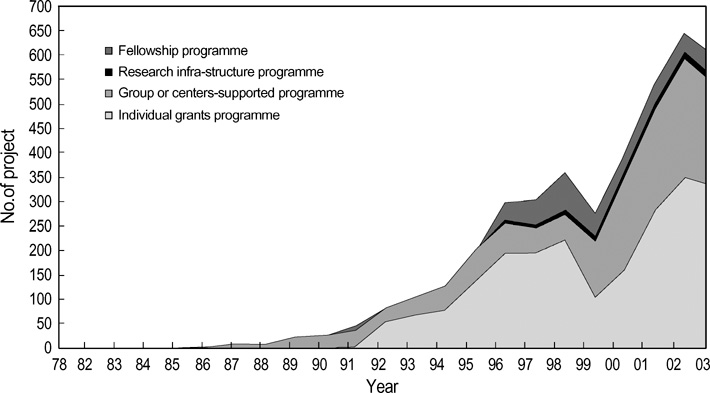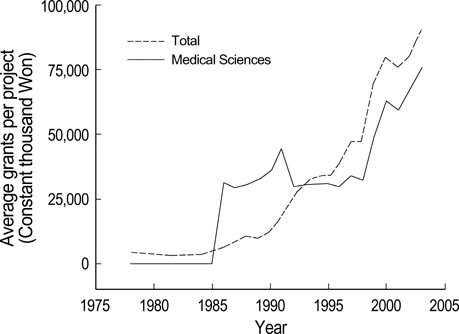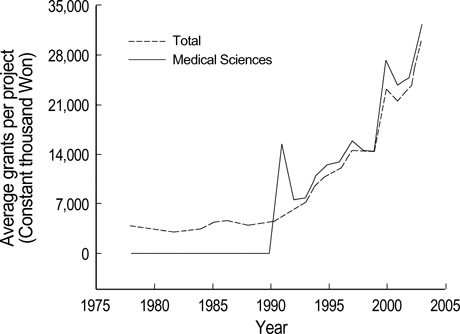J Korean Med Sci.
2005 Jun;20(3):345-354. 10.3346/jkms.2005.20.3.345.
The Medical Science Research and Development Supported by the Korea Science and Engineering Foundation
- Affiliations
-
- 1Korea Science and Engineering Foundation, Daejeon, Korea. tsmin@kosef.re.kr
- 2Mitochondrial Signaling Laboratory, Department of Physiology and Biophysics, College of Medicine, Inje University, Busan, Korea.
- 3Korea Institute of Geoscience and Mineral Resources, Daejeon, Korea.
- 4Department of Internal Medicine, College of Medicine, Inje University, Busan, Korea.
- 5Department of Physiology, College of Medicine, The Catholic University of Korea, Seoul, Korea.
- KMID: 1778488
- DOI: http://doi.org/10.3346/jkms.2005.20.3.345
Abstract
- This study examined ways of promoting research in the medical sciences by evaluating trends in research funding, and the present status of research funding by the Korea Science and Engineering Foundation (KOSEF). This study analyzed statistics from KOSEF from 1978 to 2003 to examine support for research. In medical science field, group-based programs receive more funding than do individual-based programs. The proportion of research funds allocated to the medical sciences has increased markedly each year. Researchers in the medical sciences have submitted more articles to Science Citation Index (SCI) journals than to non-SCI journals, relative to other fields. Researchers supported by the Mission-Oriented Basic Grants program have published the majority of these papers, followed by those supported by the Programs for Leading Scientists, Regional Scientists, Leading Women Scientists, Young Scientists, and Promising Women Scientists, in that order. Funding by KOSEF reflects many decades of government support for research and development, the development and maintenance of necessary infrastructure, and the education and training of medical scientists.
MeSH Terms
Figure
Reference
-
1. Jang JK. Performance analysis of investment in basic research. 2002. Daejon, Korea: KOSEF;4–5.2. Office for Official Publications of the European Community (OECD). Third European Report on Science and Technology Indicators. 2003. 96.3. Min TS, Choi HK, Kim SY, Bai SC, Kim YY, Yang MS, Chung BH, Hwang JY, Han IK. A proposal for promotion of research activities by analysis of KOSEF's basic research supports in agricultural sciences. J Korean Soc Appl Biol Chem. 2005. 48:23–33.4. National Science Foundation (NSF). Science & engineering indicators 2004. 2004. 1: 0-1~0-19, 2: A5-9~A5-11, A3-16.5. Korea Institute of S&T Evaluation and Planning (KISTEP). National R&D Expenditures in 2003. 2003. Seoul, Korea: KISTEP;63–67.6. Congress of Deans of Medical Schools in National Universities (CDMSNU). Special Report on the Development of Medical Science in the 21st Century. 2000. Seoul, Korea: CDMSNU;37–185.7. Korea Science and Engineering Foundation (KOSEF). KOSEF-supported research: citation analysis (1998-2002). 2004. Daejon, Korea: KOSEF;14–16.8. Korea Research Foundation (KRF). Annual statistics on research grants in 2004. 2004. Seoul, Korea: KRF;65–146.9. Nature. Basic research: an economic good. Nature. 1996. 382:741.10. Korea Science and Engineering Foundation (KOSEF). KOSEF Statistics 2003. 2003a. Daejon, Korea: KOSEF;317.11. Korea Science and Engineering Foundation (KOSEF). Report of research output on KOSEF activities 2003. 2003b. Daejon, Korea: KOSEF;250.
- Full Text Links
- Actions
-
Cited
- CITED
-
- Close
- Share
- Similar articles
-
- Corrigendum to: Dual mechanisms for the regulation of brain-derived neurotrophic factor by valproic acid in neural progenitor cells
- Researchers and Editors at the Heart of Science Communication
- Nursing Service R&D Strategy based on Policy Direction of Korean Government Supported Research and Development
- A Strategy to Activate the Basic Science Education in Medical School
- Celebrating the Achievements and Fulfilling the Mission of the Korean Association of Medical Journal Editors




